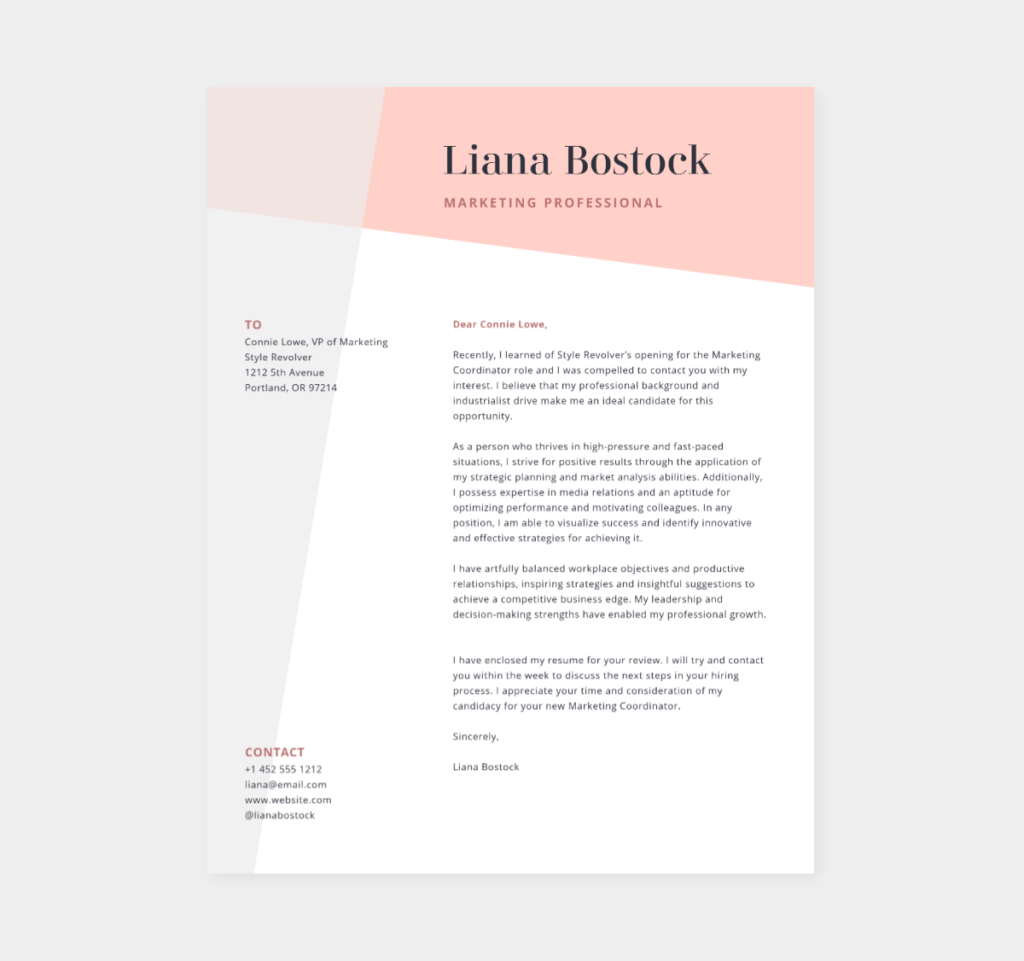Having an awesome resume is no doubt critical for a successful job search, but your cover letter is arguably just as important. The cover letter is where you have the opportunity to tell your story, show a bit of personality, and demonstrate your writing skills. So if you really want that job, you’ll need to learn how to write a cover letter that convinces hiring managers to give you a closer look.
Using a PicMonkey cover letter template is a great starting point since you’ll have the formatting and design done for you. And if you’re using one of our resume templates, you can look for a cover letter template that uses the same style, color scheme, and graphics. That type of sophisticated coordination and professional design will most definitely catch people’s eye!
How to write a cover letter with a PicMonkey template
Go to Templates and search the cover letters.
Select the one you like.
Click the Layers palette and select the text you want to change. Click inside the text box and type your text.
Click any graphic or background to change the color, size, texture, and more.
Formatting a cover letter

There’s a standard format for cover letters that most people abide by. The header contains:
Your name
Title (if appropriate)
Address
Phone number
Email address
Website address (if you have one)
Social profile links (when appropriate)
Some of this information can appear in the footer or somewhere else on the page. Then comes:
Date
Name and address of recipient
Salutation
Body of the letter
Closing
Your name and signature
While cover letters should adhere to this basic structure, there’s room for playing around a bit with the look and feel. You could create a header using color, graphics, or even your logo if you have one. You can also add design elements to the border of your letter. And feel free to experiment with margins and columns. When you choose a PicMonkey template, the formatting is taken care of for you, but you’ll always have the option of customizing to suit your needs and personal style.
Addressing the recipient of a cover letter

Little things mean a lot when it comes to cover letters, and probably the biggest little thing is the addressee. One of the worst and most common mistakes people make is addressing their letter to “Sir,” “Madam,” “To Whom It May Concern,” “Hiring Manager,” or some other generic entity. This will put people off for a couple of reasons.
First, no one wants to be thought of as a nameless Sir or Madam. Most people will read that salutation and immediately feel a bit offended, whether consciously or subconsciously. Second, doing this shows an egregious lack of initiative and thought, and a whole lot of laziness. Hiring managers expect candidates to want the job badly enough to spend a few minutes trying to find the right person to address their letter to. You can do that by searching on LinkedIn or doing a Google search on the company. Keep in mind, if you put in the wrong name, the recipient will most likely not be bothered a bit. They will appreciate that you made the effort!
Customizing a cover letter for a specific job

Another common mistake people make is writing one cover letter to use for multiple job applications, and simply changing the addressee and company name. This defeats the whole purpose of a cover letter, which should be used to show your interest in, enthusiasm for, and knowledge of the specific company and job you are applying to.
When customizing your cover letter for a particular position, be sure to include key words and phrases taken directly from the job description, so the hiring manager knows that you have what it takes to perform in this job. For example, if the description mentions needing to be a good communicator, include language about your communication skills or offer an example of work you’ve done that utilized those skills. You want the reader to see that you’d be a perfect fit for the job. Also be sure to include some language that shows you’ve done research on the company and you know what its mission, vision, and culture are all about.
You’ll also want to choose which of your achievements would be most beneficial to highlight for the particular company. Consider listing your accomplishments in a bulleted list so they’re easy to read. And it’s best if you can include quantifiable achievements, such as:
Grew social media by 50%
Managed a $2 million budget
Increased sales leads by 60%
Getting the tone right for a cover letter

Since each of your cover letters will be customized for each company you’re applying to, you’ll want to make sure that the tone of your letter is appropriate for the unique style of the company. For example, if you’re applying to a freewheeling start-up doing cutting-edge work, you can write a cover letter that echoes that feeling. But if the company is an international conglomerate that’s been around for 100 years, you’ll want to go with a more traditional style.
Remember, though, that no matter how well you think you know the company, you won’t be able to guess the personality of the hiring manager reading your letter. Even if that individual works at a funky start-up, they could be rather conservative. You really can’t go wrong if your cover letter is well written and makes you sound confident, competent, and professional. Just make sure you don’t sound too stuffy or formal.
More cover letter tips and tricks
While you definitely want to show some enthusiasm for the company, don’t go overboard. It’s better to come off as an admirer of the company’s work and history rather than an obsessive stalker.
Be sure to show some of your personality in your cover letter, but avoid getting too personal and chatty. While coming off as likable is great, the main objective is to show the reader you can do a great job.
Some people focus too much on why they want to work for a company and how much they’ll love the job. Instead, use the cover letter to demonstrate all that you can contribute to the organization.
Your cover letter shouldn’t just be a summary of what you’ve included in your resume. Use it as a way to paint a fuller picture of your skills and experience in a more narrative way, and try to add in some information that isn’t included in your resume.
Avoid making any apologies or excuses for your work history. If you don’t have exactly the right experience, educational background, or skills, there’s no need to call that out. If you accentuate the positive, the reader might not even notice (or care) if you’re not 100% perfect for the job.
